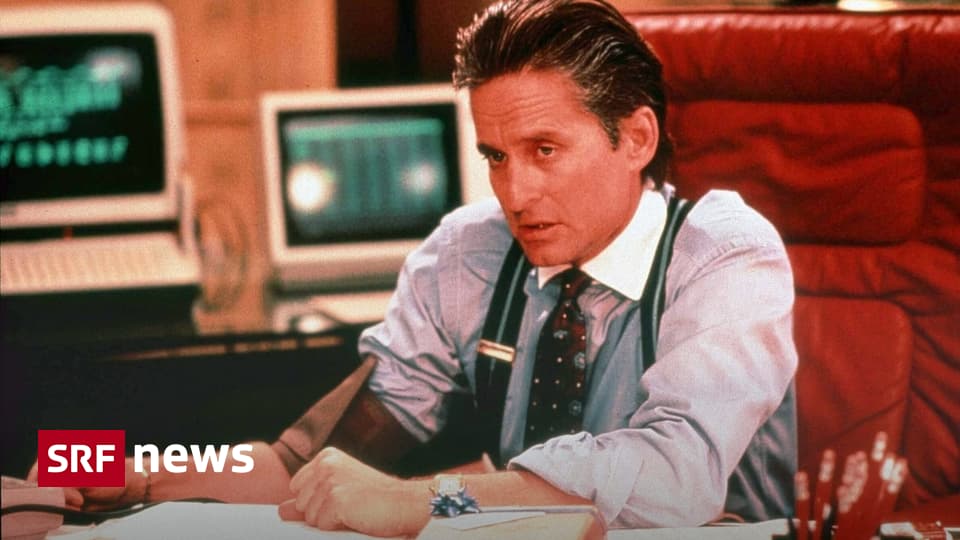Contents
At the turn of the millennium there was still pressure on the New York Stock Exchange. Today the human factor is becoming less important.
Most people only know the New York Stock Exchange from television broadcasts to business correspondents. In the background, brokers scurry across the floor, men in pinstriped suits stand in front of monitors with endless rows of numbers and move huge amounts of money as if they were playing Monopoly.
At least that’s the cliché that is fueled by films like “The Wolf of Wall Street,” in which Leonardo DiCaprio plays a stock trader consumed by greed and ambition.
Legend: The infamous stock speculator Gordon Gekko, portrayed by Michael Douglas, also left an unflattering picture of the events on the New York Stock Exchange in “Wall Street”. Imago/Ronald Grant Archive/Mary Evans
But what is really happening at the heart of the global financial industry? One person who should know is Jens Korte: the trained industrial clerk and economist has been reporting on the New York Stock Exchange for a quarter of a century. In simple terms he explains to the audience the not-so-simple processes on the NYSE.
Legend: Jens Korte reports for SRF from Wall Street in New York. The freelance stock market journalist has been working there for various media since 1999. SRF
It’s hardly ever quiet on Wall Street. These days, the US central bank’s interest rate decision (FED) is dominating the headlines. This can traditionally lead to seismographic tremors on the stock market.
Irish and Italian merchant dynasties
Open box Close box
Caption: Crowd in front of the New York Stock Exchange during the stock market crash of 1929. Keystone/AP (Archive)
Many traders on Wall Street have Irish and Italian last names. And that is no coincidence, as Jens Korte explains: When the New York Stock Exchange moved to Wall Street at the turn of the 19th and 20th centuries, Irish and Italian immigrants were cheap labor. “They then quickly realized that they could make money with it. Today you see small family clans that are still in the same place.”
There are eight regular central bank meetings annually. The result of the financial policy decision will arrive reliably at 2 p.m. New York time.
Legend: On Wall Street, the Fed’s key interest rate decisions have become a real event, reports Korte: “Shortly beforehand, a murmur goes over the floor, the traders say ‘Pssst…’ and everyone looks at the screens on which the TV stock market broadcasts are showing -stations are running.” Keystone/AP/SETH LITTLE
Nervous tension that dissolves either in general relief, casual nodding or collective horror: the same spectacle always offers funny moments, says the correspondent. “But only when something really surprising happens does someone run from one trading stand to the next. But then it quickly goes back to ‘business as usual’.”
Gone with the trader romance
However, this normal operation has changed significantly since the turn of the millennium – including the dress code. For several years now, bankers at JP Morgan and Goldman Sachs have been allowed to come to work wearing a polo shirt and shorts.
Legend: Tie is no longer mandatory. And the uniform of the West Coast – sneakers and hoodies – has also found its way onto Wall Street. In the fight for young talent, the new dress code is intended to help catch up with the casualness of Silicon Valley. Getty Images/Michael M. Santiago
Visually, something else is also noticeable: the density stress of earlier times is over on the New York Stock Exchange. When Korte started reporting on Wall Street in the late 1990s, there were still over 7,000 traders there.
“We journalists weren’t particularly welcome back then because we just stood in the way. There are far fewer dealers now. The whole system has changed a lot.” Above all, digitalization has meant that things are less blatant today.
1 / 2
Legend: The days of buying and selling stocks at trading desks are over on Wall Street: transactions have long been processed on computers. The New York Stock Exchange is no longer as crowded as it was in the 1990s (pictured). Keystone/AP/EMILE WAMSTEKER
2 / 2
Caption: There is significantly less activity on the trading floor today. Even if it still gets crowded on turbulent days. Getty Images/Spencer Platt
However, in “high-frequency trading” it is important to be as close as possible to the central server so that transactions can be concluded in milliseconds, explains Korte. “Bots programmed with complex algorithms make buying and selling decisions independently and try to profit from price differences that only exist for a short time.” Here, every additional meter of fiber optics can cost money.
Legend: Wall Street is also a lot of show today, says Korte: For example, when the stock exchange symbolically opens and closes every day with the ringing of bells. Keystone/AP/Richard Drew
According to Korte, the fact that Wall Street is still busy despite working from home and digitalization has a lot to do with tradition and prestige. The financial institutions want to mark their presence in the global financial temple. And: “If there is turbulence and IPOs on the markets, it can definitely make sense to have someone there.”
Legend: There are still veterans among the stock exchangers. In times of crisis – which there has been no shortage of since the turn of the millennium – they also give Korte a certain confidence. Because the dealers have developed a lot of nerves over the years. Image: Traders in the 2008 stock market crash. Keystone/AP/RICHARD DREW
Ultimately, the human factor still plays a certain role on Wall Street, Korte concludes. “But 90 percent of pure trading now takes place via bots. The physically present dealer is no longer so important.”
